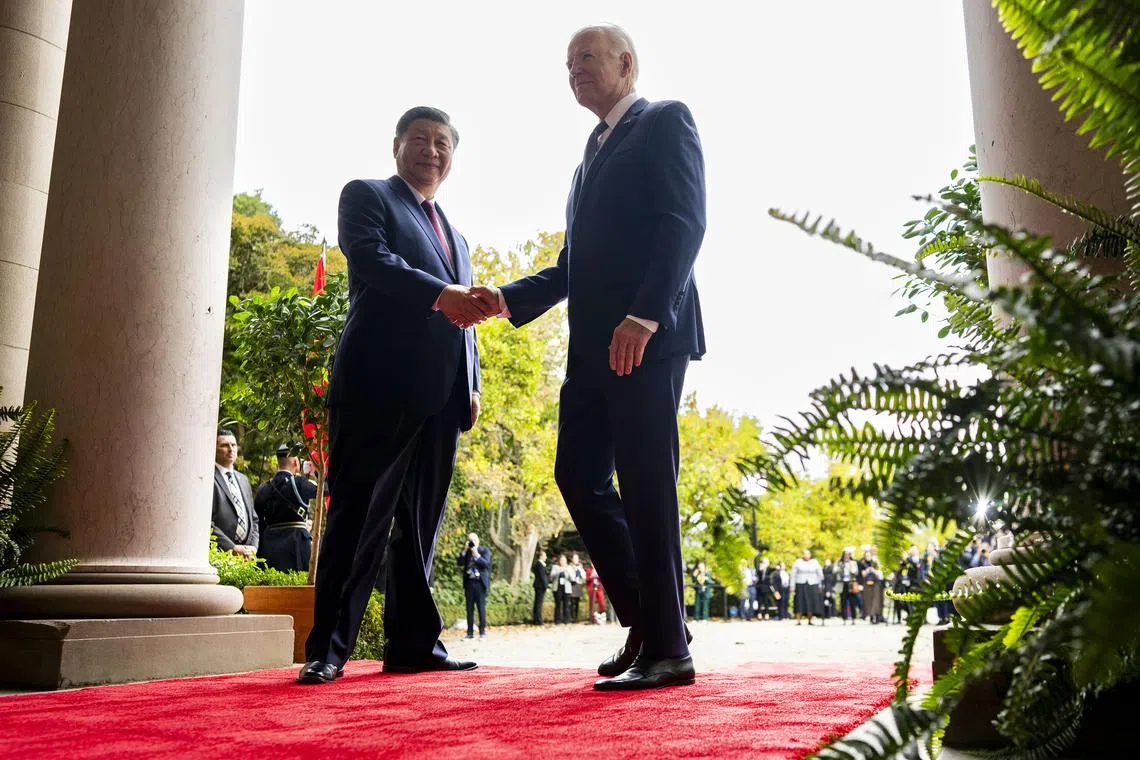What Xi got out of his meeting with Biden
The summit has been vital for the Chinese President’s bid to stabilise the domestic situation, and potentially to gain more access to US businesses.
Sign up now: Get ST's newsletters delivered to your inbox

US President Joe Biden (right) and his Chinese counterpart Xi Jinping met on the sidelines of the Apec forum on Nov 15.
PHOTO: NYTIMES
Tom Harper
Follow topic:
China’s leader Xi Jinping flew into San Francisco to meet US President Joe Biden on Nov 15 for his first visit to the United States since 2017.
The meeting a Chinese spy balloon entering US airspace
After the meeting, Mr Xi said the doors between the two countries cannot “be closed again”.
There have been some small but important steps in potentially reducing the risk of a potential Cold War. Avoiding another Cold War has been one of Mr Xi’s key objectives, outlined in what has been labelled the “Five No’s” stated at the 2021 Alaska summit between China’s director of the Office of the Central Commission for Foreign Affairs Yang Jiechi and US Secretary of State Antony Blinken. Mr Biden said after the San Francisco summit that while the China-US relationship is competitive, his responsibility is to make it “rational and manageable”.
The summit has been vital for Mr Xi’s bid to stabilise China’s domestic situation, and potentially to gain more access to US businesses. There were signs this was paying off, with a number of important US business leaders headed to San Francisco to meet the Chinese President. This comes at a time of significant turmoil in the Chinese economy
Mr Xi seeks a level playing field for Chinese firms in the US, while also aiming to show foreign investors that China is still open for business and investment. In advance of the summit, Beijing sought to win over US business leaders, who are seen as less hawkish on China than their political counterparts as well as being the primary beneficiaries of US-China trade.
This was demonstrated by the visits earlier in 2023 of Microsoft’s Mr Bill Gates and Apple’s Mr Tim Cook to China, where they received a bigger reception than many heads of state. China views the trade tensions between the US and itself as having adverse effects on US businesses too, which it hopes it can use to lobby Washington to moderate its stance towards Beijing. As a result, winning over business leaders such as Mr Cook and Mr Gates is just as important as convincing political leaders such as Mr Biden.
This summit can also be seen as furthering Beijing’s efforts to improve its relationships with many Western nations, underlined also by the visit of Australian Prime Minister Anthony Albanese to Beijing
Mr Biden’s statement that Washington does not support full Taiwanese independence, while still being concerned about Chinese military intervention on the self-governing island, gives Mr Xi a bit more breathing space to focus elsewhere, perhaps de-escalating tension between the two over the long-term future for Taiwan.
A pause in the tension with the US is potentially useful for both Beijing and Washington as they grapple with their own domestic politics, and conflicts around the world.
Possibly the most significant obstacle to Mr Xi’s goals at the summit has been the economic tensions between the US and China, which peaked under Donald Trump’s leadership. These tensions have been highlighted by the discussion over “de-risking” ties with China
Talk of “decoupling”, by cutting trade with China, has largely been dismissed by senior US officials, such as Secretary of the Treasury Janet Yellen and Senate Majority Leader Chuck Schumer.
China’s strengths
There are several reasons for China to be confident in its negotiating powers with the US. One of these can be seen in the apparent failure of the US-led trade war to stymie China’s technological development, with restrictive measures such as chip curbs resulting in Chinese firms switching to Huawei processors.
Such moves have cost US firms such as Nvidia the Chinese market
The US has its own strategic challenges, with the conflicts in Ukraine and Gaza placing American capacities under greater strain. In China’s eyes, an over-extended US is less willing to open a third front in Asia.
This further strengthens China’s position, with the additional benefit of these conflicts strengthening China’s influence in Russia and the developing world. As a result, China’s diplomatic standing and clout is perhaps stronger than expected.
So far, there have been a few token agreements such as resumption of high-level communication contact between the US and Chinese militaries, which marks a notable de-escalation in the tensions between the two.
While Apec is a step in the right direction for reducing Sino-US tensions, it is somewhat doubtful that Mr Xi has won everything that Beijing wanted. Meanwhile, Mr Biden will be scrutinised by the opposition for not giving too much away to China. This is pertinent because he faces an election in 2024, where his most likely opponent is Donald Trump, who was famous for his hardline stance on China. Consequently, any concession to Beijing may cost Mr Biden dearly in his bid to be re-elected.
What can be delivered from the summit is a pause in China-US tension rather than an end to it. In the face of the challenges in restructuring China’s economy and America’s geopolitical quagmires, perhaps breathing room is the best that Beijing and Washington can hope for.
Tom Harper is lecturer in international relations at the University of East London. This article was first published in
The Conversation.

